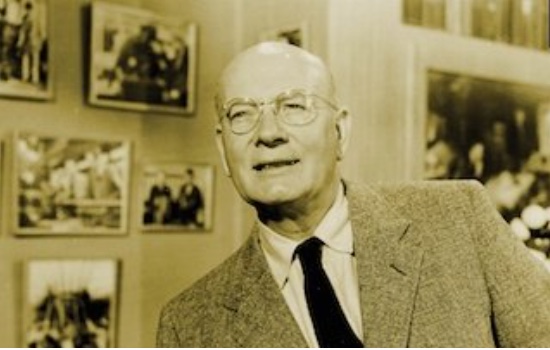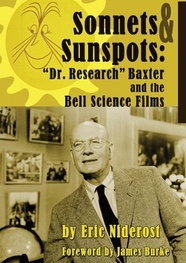TV’s First Education Superstar

In 1953 television was a still fledgling medium, yet clearly entering a very robust adolescence. In December there were 360 television stations in the United States, with 231 of them having just started in recent months. In this period TV Guide began publication, the first TV dinner made its appearance, and the first commercial color program, the Colgate Comedy Hour with Donald O’Connor, made its debut.
“I Love Lucy,” the now-classic sitcom featuring Lucille Ball and Desi Arnaz, still ruled the airwaves. On January 19, 1953, an estimated 68% of all U.S. television sets were tuned in to watch Lucy give birth to “little Ricky.” On May 25 of that year KUHT-TV, the first non-commercial educational station, began broadcasting in Houston. It was a milestone that the national press largely ignored.
 Indeed, educational TV seemed to be struggling just to
survive. The year before, in 1952, National Educational Television
(NET) was born, a network that would become the Public Broadcasting
Service (PBS) in 1970. It was a decidedly inauspicious debut. Most
of the programing was done in actual classrooms showcasing nervous
pedagogues, chalk in hand, scribbling words of wisdom on cheap
blackboards while they sweated under the searing heat of early
television lights. The overall impression was underwhelming and
hardly inspirational.
Indeed, educational TV seemed to be struggling just to
survive. The year before, in 1952, National Educational Television
(NET) was born, a network that would become the Public Broadcasting
Service (PBS) in 1970. It was a decidedly inauspicious debut. Most
of the programing was done in actual classrooms showcasing nervous
pedagogues, chalk in hand, scribbling words of wisdom on cheap
blackboards while they sweated under the searing heat of early
television lights. The overall impression was underwhelming and
hardly inspirational.
This all changed with Dr. Frank Baxter, professor of English Literature at the University of Southern California. It can be argued that Baxter, and Baxter alone, was responsible for making educational TV a popular venue for learning. There were other pioneers in the field—Don “Mr. Wizard” Herbert comes to mind—but no one came close to having the universal impact that Frank Baxter had on the American public from 1953 to 1970. A born teacher, his infectious love of learning, wide range of interests, and charismatic personality overcame the meager budgets and technical drawbacks of the early years.
Baxter started in 1953, the same year that I Love Lucy was gaining the applause of critics and public alike. A local Los Angeles TV station featured Dr. Baxter in a series called Shakespeare on TV. It was a huge hit, and eventually took the country by storm. Before long Baxter had garnered two Emmys for his work and began starring in other small-screen educational programs.
By the late 1950s and early 1960s he was everywhere on the video dial, hosting dramas, making guest appearances in sitcoms, and even trading comedic barbs on variety shows. Baxter’s status as America’s favorite academic reached new heights when he starred in a series of popular science programs sponsored by Bell Telephone. Originally aired on TV, titles like “Our Mr. Sun” (1956) and “Hemo the Magnificent” (1957) enjoyed a whole new life when transferred to 16mm film and distributed all over the country.
Frank Baxter not only single-handedly put educational television on the map, but became a cherished and indelible memory in the minds of countless Baby Boomers. His trailblazing Shakespeare series is the “ancestor” of on-line classes and telecourses offered in colleges and universities today. Certainly, he paved the way for popularizers like James Burke (Connections) and Carl Sagan (Cosmos), and Neil DeGrasse Tyson.
In 1952 Dr. Frank Baxter was one of the most popular professors at the University of Southern California, or USC. “If you haven’t taken Dr. Baxter,” the school newspaper Daily Trojan declared, “you haven’t been to college.” A student poll once voted Baxter as the man who should “teach all the classes at the university.”
But national fame was just around the corner. KNXT-TV, the CBS affiliate in Los Angeles, decided to offer a “public service time” each week at 11 am on Saturdays. The time slot was a backwater, a place where the station could appear high-minded without sacrificing the advertising revenue of later, more commercial periods.
The show was called “Shakespeare on TV,” a name that invokes both the content of the programs and their modest aims. Dr. Baxter would present 18 lectures on the Bard, each about 45 minutes long. The course could be taken for credit, audited, or simply viewed for one’s one personal enrichment.
The results were nothing less than astounding. Some 400,000 tuned in to watch the programs, 350 paid $12 to take the “class” for credit, and 900 audited. A second series was telecast, and a third. He soon was attracting audiences of 750,000, and his ratings were higher than some commercially produced shows.
New York Times writer Jack Gould came close to explaining the Baxter magic when he said the professor’s approach “is not that of an assignment in literature. Rather it is an adventure to which he brings a sense of enthusiastic discovery that he delights in sharing with his student or viewer.”
In the 1950s academics were supposed to be remote, almost “otherworldly” intellectuals whose thought patterns were incomprehensible to the average mortal. Occasionally they might descend from “Mount Olympus” to lecture the common herd, but they were supposed to be achingly dull and totally boring. Given these attitudes, Baxter was a revelation. He may have looked like an academic, with his wire-framed glasses, bald pate, and grey-flannel suit, but he didn’t act like one.
Famed Hollywood director Frank Capra watched Baxter on television and became an immediate fan. He contacted Baxter and asked him to be the lead in a popular science program he was producing and directing for television called “Our Mr. Sun.” McCarthyism was rampant, and Capra had fallen victim to the anti-communist “witch hunt” mentality of the era. He was cleared, but his film career was somewhat in limbo.
The director, who also had a degree in chemical engineering, agreed when Bell Telephone, the subsidiary of AT and T, asked him to do a popular science series on television. The atomic age had spawned the fear of nuclear destruction, and science was blamed. Bell hoped these programs would change the public’s perception.
“Our Mr. Sun” aired on CBS at 10 pm on November 19, 1956. “Mr. Sun” was a great success, reaching over 24 million viewers in the United States and Canada. In fact, it took the viewing public by storm.
“Sun” was a unique blend of actual scientific footage, live action, and cartoon animation. Frank Baxter plays “Dr. Research,” an obviously generic scientist. Actor Eddie Albert, best known for his 60s sitcom “Green Acres,” plays a fiction writer. Baxter and Albert interact with a whole range of cartoon characters, including Father Time, Thermo the Magician, and the star of the show himself, Mr. Sun.
Frank Baxter starred in eight of the nine Bell Science shows that were produced and aired from 1956 to 1964. Capra produced and directed the first four: “Our Mr. Sun,” “Hemo the Magnificent,” “The Strange Case of the Cosmic Rays,” and “Meteora, the Unchained Goddess.” The latter, primarily about the weather, is notable for its segment on the dangers of global warming. It’s remarkably prescient for 1958.
The next four Bell Science programs were produced by Warner Brothers Studios. They are noted for their striking sets and imaginative displays. The Warner titles include “Gateways to the Mind,” “The Alphabet Conspiracy,” “The Thread of Life,” and “About Time.” Walt Disney did the last of the series, “The Restless Sea,” that did not use Baxter’s services.
These films were converted to 16mm film and distributed for free to schools across the nation. They were in vogue until the 1980s, making Baxter a cultural icon to millions of students from grade school to college. Though understandably dated in spots, the programs still hold up in basic information.
Dr. Frank C. Baxter died of a heart attack on January 18, 1982, at the age of 85. Today there are thousands of baby boomers, and even post-baby boomers, who have fond memories of the affable professor.
Baxter and the Bell films provided a template for popular science programing that continues to this day. The formula includes a charismatic host, engaging animation, humor, and easy to understand, accessible information presented in an entertaining way. PBS and the general public owe a debt of gratitude to Frank Baxter, the man who proved that educational television was not only feasible, but fun.
